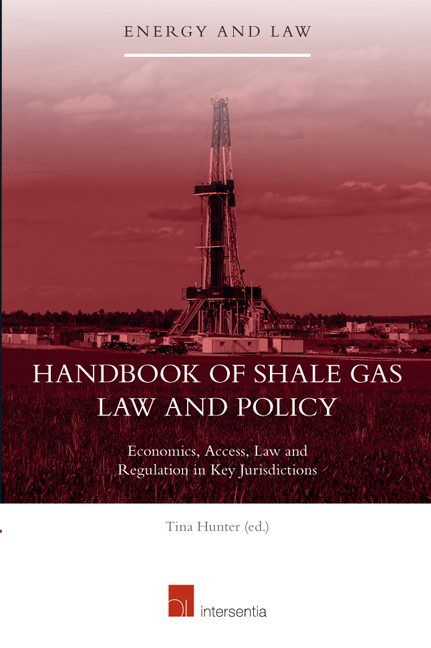Book contents
- Frontmatter
- Preface
- Contents
- List of Tables and Figures
- List of Authors
- Part I Overview and Introduction to Shale Gas Activities
- Part II Shale Gas Economics and Energy Security
- Part III Access to Shale Gas Resources
- Granting of Shale Gas Licences, Land Access and Property Rights in North America
- Granting of Shale Gas Licences, Land Access and Property Rights in Australia
- Shale Gas Licensing in the United Kingdom
- Part IV Shale Gas Law and Regulation
- Part V The Future of Shale Gas in the United Kingdom
- Index
Granting of Shale Gas Licences, Land Access and Property Rights in North America
from Part III - Access to Shale Gas Resources
Published online by Cambridge University Press: 21 September 2018
- Frontmatter
- Preface
- Contents
- List of Tables and Figures
- List of Authors
- Part I Overview and Introduction to Shale Gas Activities
- Part II Shale Gas Economics and Energy Security
- Part III Access to Shale Gas Resources
- Granting of Shale Gas Licences, Land Access and Property Rights in North America
- Granting of Shale Gas Licences, Land Access and Property Rights in Australia
- Shale Gas Licensing in the United Kingdom
- Part IV Shale Gas Law and Regulation
- Part V The Future of Shale Gas in the United Kingdom
- Index
Summary
INTRODUCTION
This chapter considers the nature of property rights granted to industry operators and the property rights of landowners, as well as presenting a picture of North American regulatory systems for shale resource development. In this review, focus is mainly on what can be described as ‘mature’ oil and gas jurisdictions – those that have a history of oil and gas development, appropriate legal and regulatory frameworks, and at least some citizen experience with and understanding of the oil and gas industry. This is by contrast with ‘new’ potential shale oil and gas jurisdictions that lack this history, law regulatory expertise and experience, and citizen experience.
PERMITS AND LICENCES FOR SHALE GAS ACTIVITIES
In both the US and Canadian mature oil and gas jurisdictions, energy regulatory regimes at the state or provincial level have been long addressed oil and gas exploration, drilling, production, transportation and related activities. They are primarily permitting systems backed by regulatory penalties – classic command and control regulation.
Operators proposing to drill a well must apply to a state or provincial regulatory agency for a permit or licence to drill. Regulations specify information required to be filed by applicants. Permits may be subject to terms and conditions specified by the regulator. Regulators evaluate permit applications in light of standards established to protect public health and safety as well as the environment, also taking into consideration social and economic factors – impacts on aff ected persons and communities, cost-eff ectiveness and technical feasibility. Overall, regulators act in accordance with the public interest taking into account these various factors.
If hydraulic fracturing is proposed, this may be addressed by regulators either as an element of well permit decisions or as in Colorado in additional authorisations for ‘enhanced recovery operations’. Regulators are well aware of issues raised by proposed multistage hydraulic fracturing operations. These include: drilling technology (particularly to address wellbore integrity and potential interwellbore communication), site disturbance, community and regional impacts, water supply and potential contamination, fracturing fluid use and content disclosure, potential induced seismicity, and air emissions.
It can be seen that some of these issues, particularly technology and operating requirements, are addressed by terms and conditions of permits.
- Type
- Chapter
- Information
- Handbook of Shale Gas Law and PolicyEconomics, Access, Law and Regulation in Key Jurisdictions, pp. 139 - 156Publisher: IntersentiaPrint publication year: 2016

